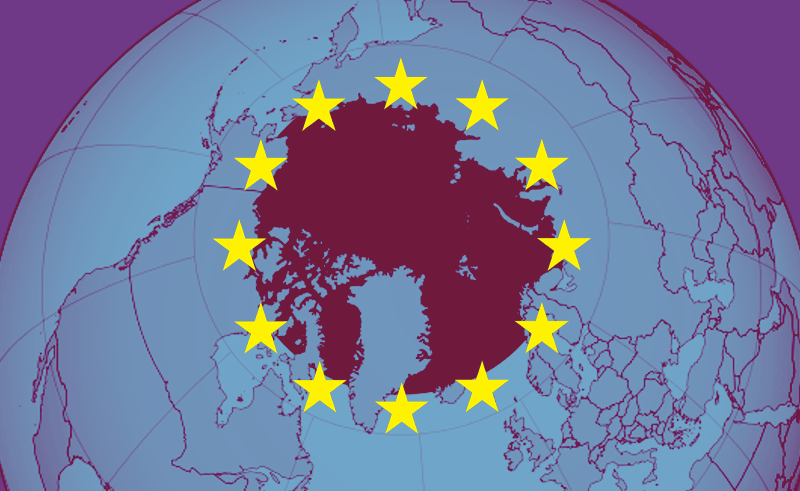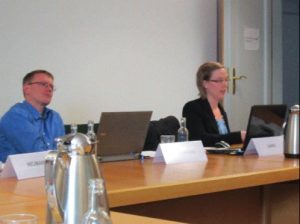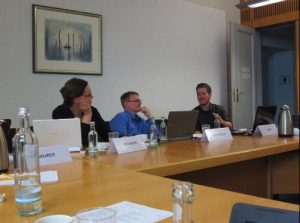Does the EU Need an Arctic Strategy?

Illustration: Juan M. Sarabia
As policy-makers, think tank representatives, and researchers met in Berlin for the third annual “Geopolitics in the High North” conference, the EU’s role in the Arctic was the main topic on the agenda. It was debated whether there is a need for an overarching EU Arctic strategy given the complexity and distinctiveness of many Arctic issue areas. How the EU is going to proceed in terms of its anticipated Arctic strategy remained rather vague.
Titled “The EU as an Arctic Actor? Interests and Governance Challenges”, the three day conference gathered numerous scholars and officials dealing with Arctic matters. The conference was arranged by the SWP in Berlin, with assistance of the GeoNor project leader from Norway, the Norwegian Institute for Defence Studies (IFS). The Arctic Institute was actively present, with members of the institute presenting and moderating during different parts of the conference.
Critical Arctic States
As always in the European debate, the Arctic states (during the conference represented by Norway and Denmark) emphasized their individual sovereignty and right to exploit natural resources accordingly. Skepticism towards the role of the European Commission in the Arctic Council was expressed, should it obtain the observer status it seeks. It was asked if the Commission’s role would be to coordinate the EU-members positions internally in the Council (Denmark, Sweden, Finland and possible Iceland). Further, the EU’s application for permanent observer status is interlinked with the same application from China, which broadens and complicates the overall issue of more observers to the Arctic Council.
There was often-stated skepticism towards the EU’s tendency to interfere in the Arctic states’ internal economic affairs. One participant stated: “It is easy for those outside of the Arctic to talk about how we manage our own resources in the Arctic.” Naturally, the EU’s import ban on seal products was referenced, but also Greenland’s development of its offshore oil and gas resources was a part of the discourse.
EU-Arctic policy – for whom and for what?
In accordance with the Commission’s first Arctic Communication from 2008, the EU sees its Arctic role primarily in the issue areas climate change and research, and as an important market for Arctic products. Proponents of an active EU role in the Arctic made sure to mention that the EU does not want to interfere with the Arctic states’ interests, but that the EU can contribute to a better governance structure and sustainable resource development in the region. While the type of statements related to governance is what has caused some negative reactions amongst the Arctic littoral states before, the tone was at large very amenable from the EU level.
It is interesting to notice how much time at large the European Commission spends on legitimizing its involvement in the Arctic, ranging from climate change footprint studies to the fact that the EU also has policies for the Mediterranean and the Baltic Seas. It should, however, be highlighted that the EU has direct access to the Mediterranean and the Baltic Seas, while it has no such access to the Arctic Ocean. One participant also pointed out that the EU’s negative impact on Arctic climate should rather spur a more aggressive internal climate policy for the EU-member states instead of being used as an argument for EU engagement in the Arctic.
In other words, the EU discourse did not entail any new concepts, nor did it bring with it any new revelations on how the Commission will make their Arctic policy into something more tangible than mere policy statements on paper. The expected progress report from the Commission was also a hot topic amongst the conference participants, as it was expected to be released at the end of May. Delayed numerous times already, there is now talk about it not being released before summer 2012.
Later on in the conference the purpose of a holistic Arctic strategy was openly questioned, as individual policies should be sufficient to deal with the policy areas where the EU interacts with the Arctic region. The argument was that the EU is not involved in all Arctic issue areas to the same extent, and consequently does not need an overarching strategy for a region where it does not have primacy. Arctic specific policies for raw materials, energy, transport, fisheries, climate change and research should all be adequate to deal with the EU’s interests in the region.
Governance, Resources, Environment and Shipping
After drawing the overall picture, the conference moved on to concrete policy sections. In the section on Arctic governance, the importance of narratives or the way we discuss the Arctic was emphasized. The argument was that the way the Arctic is portrayed by media, policy-makers and scientist influences the actual decisions we take about the region. Additionally, the Arctic region as a whole is closely linked to the rest of the globe. Climatic changes in the Arctic will have decisive effects on regions further south, e.g. through rising sea levels due to continued melting of the Greenlandic ice sheet.
In the natural resources section, Andreas Østhagen from The Arctic Institute presented a study looking at factors driving and hindering the development of offshore oil and gas in the North American Arctic. Regional autonomy, commercial infrastructure and accessibility, and civic involvement all determine the pace of offshore development in Alaska, Canada and Greenland. The presentation made clear that it very often does not make sense to treat the Arctic as one, homogenous entity with one-size-fits-all solutions. Rather, the Arctic consists of very distinct countries and regions that need to be addressed according to their own special challenges, opportunities, needs and interests. Read more about the study here, and click here for the presentation.
Two prominent Arctic scholars discussed the EU’s Arctic environmental involvement by asking one decisive question: “Is there an Arctic need for additional European commitment and policy input?” It was emphasized that only little of the EU’s environmental legislation applies in the Arctic. Further, there is a fairly progressive international system regulating environmental issues already in place. Yet it was admitted that global environmental challenges do not only affect the Arctic region but can only be dealt with by incorporating all actors, including the European Union. In that regard, many Arctic problems need non-Arctic solutions. Consequently, the European Union could considerably raise the level of global environmental ambitions considering the Arctic region.
Andreas Raspotnik from The Arctic Institute participated as a discussant in the session on “Shipping and Transport: EU Interests and Governance Challenges”. He emphasized that prospects for Arctic shipping are often described by a rather simple formula: shorter distances allow for faster trips and consequently lead to lower costs. Yet the economic picture of Arctic shipping is much more complex. Another presentation outlined the EU’s legal governance challenges as an international actor in the regulation of merchant shipping in the Arctic Ocean. It was noted that EU Member States that are members of the Arctic Council could already actively engage in the Council in relation to the regulation of merchant shipping.
This was the last annual conference for the “Geopolitics in the High North”-project, as the project runs until 2013. Parts of next year’s Arctic Frontiers conference in Tromsø, from the 20th to the 25th of January, will be devoted to the final results of the project, where also The Arctic Institute will be present and participate. For more information, click here.
Academic Workshop
Subsequent to the conference, the SWP organized a Young Researchers Workshop on “Recent Development and Studies in European Arctic Research”, where two members of The Arctic Institute, Kathrin Keil and Andreas Raspotnik, participated. Kathrin Keil presented “The Arctic Infrastructure Survey” and Andreas Raspotnik a paper on “The Future of Arctic Shipping along the Transpolar Route”. The abstracts of both papers are below. Both presentations were found to highlight important knowledge gaps in Arctic studies.
ABSTRACT: The Arctic Infrastructure Survey – Present Status and Future Outlook of Infrastructure in Arctic Littoral States
The Arctic Infrastructure Survey (AIS) provides an overview of key infrastructure in the six littoral Arctic States, which include the United States of America, Canada, Denmark/Greenland, Iceland, Norway, and Russia. This version of The Arctic Infrastructure Survey is an excerpt from a larger report (to be released by The Arctic Institute in October 2012) that will cover a wide variety of both “hard” infrastructure, defined as physical structures and networks, and “soft” infrastructure, defined as intangible systems, institutions, and organizations, that together dictate the fundamental parameters by which a nation functions.

The paper focuses specifically on transport, maritime, and energy infrastructure. A summary of the present state of infrastructure in these three areas is presented for each of the six respective Arctic littoral countries. Although there are huge variations between the Arctic nations in the current status of their infrastructure, in all cases it can be argued that their transport, maritime, and energy infrastructure are areas that will hold an exceptionally prominent role in any Arctic activities in the coming decades. Within these three infrastructure issue areas, a further focus of this paper is how these interconnected capacities specifically relate to the challenges and opportunities inherent in oil and gas exploitation and the usage of Arctic sea routes.
Predicted increases in human activity will place new, more strenuous demands on the infrastructure required to provide emergency response capabilities, support safe shipping, protect the environment, as well as further sustainable development of the Arctic region. Major investment is required in infrastructure and surveillance to enable safe economic activity. In most areas in the Arctic, infrastructure is currently insufficient to meet the expected demands of economic development. It is likely that public/private cooperation, as well as continued international cooperation among the Arctic States, will be needed to provide and sustain this infrastructure.
The greatest unknown variable in surveying Arctic Infrastructure is climate change, which will undoubtedly bring about many challenges but also opportunities in the region. Given conditions of rapid change in the physical Arctic environment, all areas of Arctic infrastructure will need to adapt to a much wider range of potential environmental conditions over the course of a multi-decade life. This means that future infrastructure may have to conform to vastly different specifications, and may be more expensive or challenging to build and maintain. It also means that various elements of infrastructure will necessarily expand and contract in response to changing conditions in unpredictable ways. In the final section of the paper, the impact of climate change on infrastructure is examined through a case study concerning the predicted consequences for Iceland’s infrastructure.
ABSTRACT: The Future of Arctic Shipping along the Transpolar Route
Arctic sea ice is melting rapidly, and within the next decade polar warming may transform the High North from an inaccessible frozen desert into a seasonally navigable ocean. The debate over Arctic shipping routes routinely evolves around the Northwest Passage and the Northern Sea Route, but neglects to make mention of the Transpolar Sea Route (TSR). In the 20th century the use of Polar routes revolutionized international air travel. In similar fashion, the TSR bears the potential to transform the international commercial shipping industry in the 21st century.

Malte Humpert and Andreas Raspotnik discuss the potential of the TSR as a future corridor of commercial shipping and conduct the first comprehensive analysis of the climatic, economic, and legal context. The article will examine the feasibility of the TSR with respect to the continued decline of Arctic sea ice and analyze the economic potential of the route and its compatibility with existing trade patterns for three types of commercial transport: Container Ships, Dry-Bulk Carriers, and Tankers. The authors will also discuss the TSR’s special status as the only Arctic shipping route outside of national territorial jurisdiction. Special emphasis will be given to China’s emerging interest in Arctic shipping and its growing economic relationship with Iceland, which stands to gain massively if it were to develop into a transpolar shipping hub. This multi-faceted and interdisciplinary study aims to outline and elaborate on a range of key issues and challenges related to the future of the TSR.
The article will be published in the forthcoming Arctic Yearbook 2012, edited by Lassi Heininen, Joël Plouffe and Heather Exner-Pirot: https://arcticyearbook.com/arctic-yearbook/2012